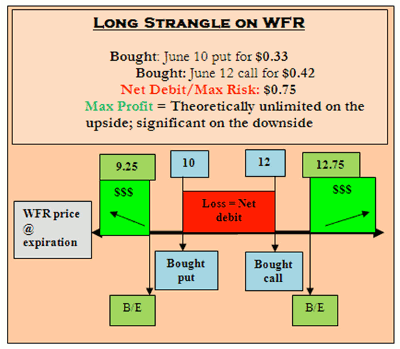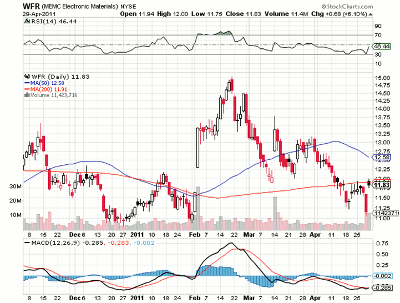With earnings upcoming, see how one trader executed a long strangle, which profits from a significant price swing in any direction while still keeping losses limited and clearly defined.
Silicon wafer manufacturer MEMC Electronic Materials, Inc. (WFR) is standing in the proverbial on-deck circle, with the firm scheduled to unveil its first-quarter earnings figures this Wednesday, May 4.
Nevertheless, the security's shorter-term options are still fairly priced at the moment, as evidenced by the stock's Schaeffer's Volatility Index (SVI) of 51%, which ranks in the 48th percentile of its annual range.
One options trader is taking advantage of relatively attractive premiums by constructing a two-strike volatility play.
This past Friday (April 29), the trader bought a block of June 10 puts for the ask price of $0.33 apiece, and simultaneously purchased a symmetrical block of June 12 calls for the ask price of $0.42 each. In other words, the speculator initiated a long strangle on WFR for a net debit of $0.75 per pair of options.
By "strangling" the stock with both calls and puts, the trader is hoping for a significant price swing in either direction within the options' lifetime.
Specifically, the intrinsic value of one option will exceed the loss incurred from the other (resulting in a profit) as long as WFR breaches one of two breakeven rails by June options expiration: the $9.25 level (put strike minus net debit) on the downside, or the $12.75 level (call strike plus net debit) on the upside.
On the flip side, even if the equity remains pinned between the strikes over the next couple of months, the most the trader can possibly forfeit is limited to the $0.75 paid to initiate the strategy.
While the aforementioned options trader has taken the directionless road less traveled, the analyst crowd harbors a distinctly more bearish bias toward the equity. According to Zacks, WFR has earned just eight "buy" or better ratings, compared to 14 "hold" or worse suggestions. In the same vein, short interest on the security shot almost 18% higher during the past month, and now accounts for a healthy 5.1% of the stock's total available float.
However, the skepticism surrounding WFR could, in part, be due to the company's less-than-impressive history in the earnings spotlight. According to Thomson Reuters, the firm has fallen woefully short of analysts' per-share profit predictions in each of the past four quarters.
Plus, WFR's lackluster price action of late is also a likely contributor to the pessimism plaguing the security. Since skimming the $15 level in mid-February, the stock has surrendered roughly 27%, with the most recent leg of its downtrend highlighted by resistance at its ten-day moving average, a trend line that's rejected all but two of WFR's rally attempts in April.
Now, the equity is clinging to support in the $11-$11.20 vicinity, which provided a technical backstop in late 2010 and early 2011.
Nevertheless, even if WFR snaps its losing streak in the earnings confessional this week, any rebound attempts could run into a short-term roadblock in the $12-$13 neighborhood.
Specifically, the overhead 12 and 13 strikes are home to more than 14,000 calls combined in the May series of options, which could exert options-related resistance as front-month expiration approaches.
By Andrea Kramer, contributor, Schaeffer’s Trading Floor Blog























